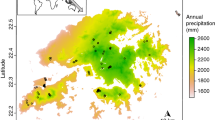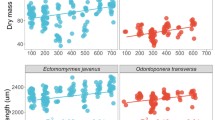Abstract
A functional traits-based theory of organismal communities is critical for understanding the principles underlying community assembly, and predicting responses to environmental change. This is particularly true for terrestrial arthropods, of which only 20 % are described. Using epigaeic ant assemblages, we asked: (1) can we use morphological variation among species to predict trophic position or preferred microhabitat; (2) does the strength of morphological associations suggest recent trait divergence; (3) do environmental variables at site scale predict trait sets for whole assemblages? We pitfall-trapped ants from a revegetation chronosequence and measured their morphology, trophic position [using C:N stoichiometry and stable isotope ratios (δ)] and characteristics of microhabitat and macrohabitat. We found strong associations between high trophic position (low C:N and high δ15N) in body tissue and morphological traits: predators were larger, had more laterally positioned eyes, more physical protection and tended to be monomorphic. In addition, morphological traits were associated with certain microhabitat features, e.g. smaller heads were associated with the bare ground microhabitat. Trait-microhabitat relationships were more pronounced when phylogenetic adjustments were used, indicating a strong influence of recent trait divergences. At the assemblage level, our fourth corner analysis revealed associations between the prevalence of traits and macrohabitat, although these associations were not the same as those based on microhabitat associations. This study shows direct links between species-level traits and both diet and habitat preference. Trait-based prediction of ecological roles and community structure is thus achievable when integrating stoichiometry, morphology and phylogeny, but scale is an important consideration in such predictions.




Similar content being viewed by others
References
Ackerly DD, Cornwell WK (2007) A trait-based approach to community assembly: partitioning of species trait values into within- and among-community components. Ecol Lett 10:135–145
Andrew NR, et al. (2013) Assessing insect responses to climate change: what are we testing for? Where should we be heading? PeerJ 1:e11
Arnan X, Cerda X, Rodrigo A, Retana J (2013) Response of ant functional composition to fire. Ecography 36:1182–1192. doi:10.1111/j.1600-0587.2013.00155.x
Barton PS, Gibb H, Manning AD, Lindenmayer DB, Cunningham SA (2011) Morphological traits as predictors of diet and microhabitat use in a diverse beetle assemblage. Biol J Linn Soc 102:301–310. doi:10.1111/j.1095-8312.2010.01580.x
Bihn JH, Gebauer G, Brandl R (2010) Loss of functional diversity of ant assemblages in secondary tropical forests. Ecology 91:782–792
Blackburn TM, Gaston KJ (1998) Some methodological issues in macroecology. Am Nat 151:68–83. doi:10.1086/286103
Blüthgen N, Gebauer G, Fiedler K (2003) Disentangling a rainforest food web using stable isotopes: dietary diversity in a species-rich ant community. Oecologia 137:426–435
Brown AM, Warton DI, Andrew NR, Binns M, Cassis G, Gibb H (2014) The fourth-corner solution—using predictive models to understand how species traits interact with the environment. Methods Ecol Evol 5:344–352
Cerdá X, Retana J, Cros S (1997) Thermal disruption of transitive hierarchies in Mediterranean ant communities. J Anim Ecol 66:363–374
Chown SL (2012) Trait-based approaches to conservation physiology: forecasting environmental change risks from the bottom up. Philos Trans R Soc B 367:1615–1627. doi:10.1098/rstb.2011.0422
Chown SL, Gaston KJ (2010) Body size variation in insects: a macroecological perspective. Biol Rev 85:139–169
Cornwell WK et al (2008) Plant species traits are the predominant control on litter decomposition rates within biomes worldwide. Ecol Lett 11:1065–1071
Davidson DW (2005) Ecological stoichiometry of ants in a New World rain forest. Oecologia 142:221–231
DeNiro MJ, Epstein S (1979) Influence of diet on the distribution of carbon isotopes in animals. Geochim Cosmochim Acta 42:495–506
DeNiro MJ, Epstein S (1981) Influence of diet on the distribution of nitrogen isotopes in animals. Geochim Cosmochim Acta 45:341–351
Diamond SE et al (2012) A physiological trait-based approach to predicting the responses of species to experimental climate warming. Ecology 93:2305–2312
Eisner T (1957) A comparative morphological study of the proventriculus of ants (Hymenoptera: Formicidae). Bull Mus Comp Zool 116:429–490
Entling W, Schmidt-Entling MH, Bacher S, Brandl R, Nentwig W (2010) Body size–climate relationships of European spiders. J Biogeogr 37:477–485
Fagan WF et al (2002) Nitrogen in insects: implications for trophic complexity and species diversification. Am Nat 160:784–802. doi:10.1086/343879
Feener DH, Lighton JRB, Bartholomew GA (1988) Curvilinear allometry, energetics and foraging ecology: a comparison of leaf-cutting ants and army ants. Funct Ecol 2:509–520. doi:10.2307/2389394
Felsenstein J (1985) Phylogenies and the comparative method. Am Nat 125:1–15
Fowler HG, Forti LC, Brandao CRF, Delabie JHC, Vasconcelos HL (1991) Ecologia nutricional de formigas. In: Panizzi AR, Parra JRP (eds) Ecologia nutricional de insetos. Manole, São Paulo, pp 131–223
Freckleton RP (2009) The seven deadly sins of comparative analysis. J Evol Biol 22:1367–1375. doi:10.1111/j.1420-9101.2009.01757.x
Funk JL, Cleland EE, Suding KN, Zavaleta ES (2008) Restoration through reassembly: plant traits and invasion resistance. Trends Ecol Evol 23:695–703
Garland T, Ives AR (2000) Using the past to predict the present: confidence intervals for regression equations in phylogenetic comparative methods. Am Nat 155:346–364
Garland T, Midford PE, Ives AR (1999) An introduction to phylogenetically based statistical methods, with a new method for confidence intervals on ancestral values. Am Zool 39:374–388
Gibb H, Cunningham SA (2011) Habitat contrasts reveal a shift in the trophic position of ant assemblages. J Anim Ecol 80:119–127
Gibb H, Cunningham SA (2013) Restoration of trophic structure in an assemblage of omnivores, considering a revegetation chronosequence. J Appl Ecol 50:449–458. doi:10.1111/1365-2664.12054
Gibb H, Parr CL (2010) How does habitat complexity affect ant foraging success? A test of functional responses on three continents. Oecologia 164:1061–1073
Gibb H, Parr CL (2013) Does structural complexity determine the morphology of assemblages? An experimental test on three continents. PLoS One 8:e64005. doi:10.1371/journal.pone.0064005
Gibb H, Ball JP, Atlegrim O, Johansson T, Hjältén J, Danell K (2005) The effects of management on coarse woody debris volume and quality in boreal forests in northern Sweden. Scand J For Res 20:213–222
Greenslade PJM (1973) Sampling ants with pitfall traps: digging-in effects. Insect Soc 20:343–353
Harvey PH, Pagel MD (1991) The comparative method in evolutionary biology. Oxford University Press, Oxford
Kaspari M (1993) Body-size and microclimate use in Neotropical granivorous ants. Oecologia 96:500–507
Langlands PR, Brennan KEC, Framenau VW, Main BY (2011) Predicting the post-fire responses of animal assemblages: testing a trait-based approach using spiders. J Anim Ecol 80:558–568
Liang KY, Zeger SL (1986) Longitudinal data analysis using generalized linear models. Biometrika 73:13–22
McGill BJ, Enquist BJ, Weiher E, Westoby M (2006) Rebuilding community ecology from functional traits. Trends Ecol Evol 21:178–185
Michaud JP, Grant AK (2003) Intraguild predation among ladybeetles and a green lacewing: do the larval spines of Curinus coeruleus (Coleoptera : coccinellidae) serve a defensive function? Bull Entomol Res 93:499–505. doi:10.1079/Ber2003269
Moreau CS, Bell CD, Vila R, Archibald SB, Pierce NE (2006) Phylogeny of the ants: diversification in the age of angiosperms. Science 312:101–104
Oster GF, Wilson EO (1978) Caste and ecology in the social insects. Princeton University Press, NJ
Paradis E, Claude J, Strimmer K (2004) APE: analyses of phylogenetics and evolution in R language. Bioinformatics 20:289–290
Ponsard S, Arditi R (2000) What can stable isotopes (d15N and d13C) tell about the food web of soil macro-invertebrates? Ecology 81:852–864
R Development Core Team (2013) R: a language and environment for statistical computing. R Foundation for Statistical Computing, Vienna
Renner IW, Warton DI (2013) Equivalence of MAXENT and Poisson point process models for species distribution modeling in ecology. Biometrics 69:274–281
Sarty M, Abbott KL, Lester PJ (2006) Habitat complexity facilitates coexistence in a tropical ant community. Oecologia 149:465–473
Shattuck SO (1999) Australian Ants: their biology and identification. CSIRO, Collingwood
Shipley B, Vile D, Garnier E (2006) From plant traits to plant communities: a statistical mechanistic approach to biodiversity. Science 314:812–814. doi:10.1126/science.1131344
Silva RR, Brandão CRF (2010) Morphological patterns and community organization in leaf-litter ant assemblages. Ecol Monogr 80:107–124
Stoklosa J, Gibb H, Warton DI (2014) Fast forward selection for generalized estimating equations with a large number of predictor variables. Biometrics 70:110–120. doi:10.1111/biom.12118
Tillberg CV, Mccarthy DP, Dolezal AG, Suarez AV (2006) Measuring the trophic ecology of ants using stable isotopes. Insect Soc 53:65–69
Weber NA (1938) The biology of the fungus-growing ants. Part 4. Additional new forms. Part 5. The Attini of Bolivia. Rev Entomol 9:154–206
Weiser MD, Kaspari M (2006) Ecological morphospace of new world ants. Ecol Entomol 31:131–142
Westoby M, Wright IJ (2006) Land-plant ecology on the basis of functional traits. Trends Ecol Evol 21:261–268
Wiescher PT, Pearce-Duvet JMC, Feener DH (2012) Assembling an ant community: species functional traits reflect environmental filtering. Oecologia 169:1063–1074. doi:10.1007/s00442-012-2262-7
Wilson EO (1953) The origin and evolution of polymorphism in ants. Q Rev Biol 28:136–156
Wittlinger M, Wolf H, Wehner R (2007) Hair plate mechanoreceptors associated with body segments are not necessary for three-dimensional path integration in desert ants, Cataglyphis fortis. J Exp Biol 210:375–382. doi:10.1242/Jeb.02674
Yates ML, Andrew NR, Binns M, Gibb H (2014) Morphological traits: evidence of predictable responses to habitat characteristics across bio-regions. PeerJ 2:e271
Acknowledgments
We thank N. Banks, K. Pullen, E. Finlay and L. Garrett for help with field work and M. Cosgrove for assistance in the laboratory. We are grateful to the farmers of Murrumbateman, Bungendore and Boorowa, who allowed us to work on their land and Greening Australia for providing contacts. S. Shattuck kindly provided ant identifications. This project was supported through an Office of the Chief Executive postdoctoral fellowship to H. G. and an Australian Research Council Discovery Project (DP0985886) to D. I. W., N. R. A. and H. G.
Author information
Authors and Affiliations
Corresponding author
Additional information
Communicated by Konrad Fiedler.
Electronic supplementary material
Below is the link to the electronic supplementary material.
Rights and permissions
About this article
Cite this article
Gibb, H., Stoklosa, J., Warton, D.I. et al. Does morphology predict trophic position and habitat use of ant species and assemblages?. Oecologia 177, 519–531 (2015). https://doi.org/10.1007/s00442-014-3101-9
Received:
Accepted:
Published:
Issue Date:
DOI: https://doi.org/10.1007/s00442-014-3101-9




